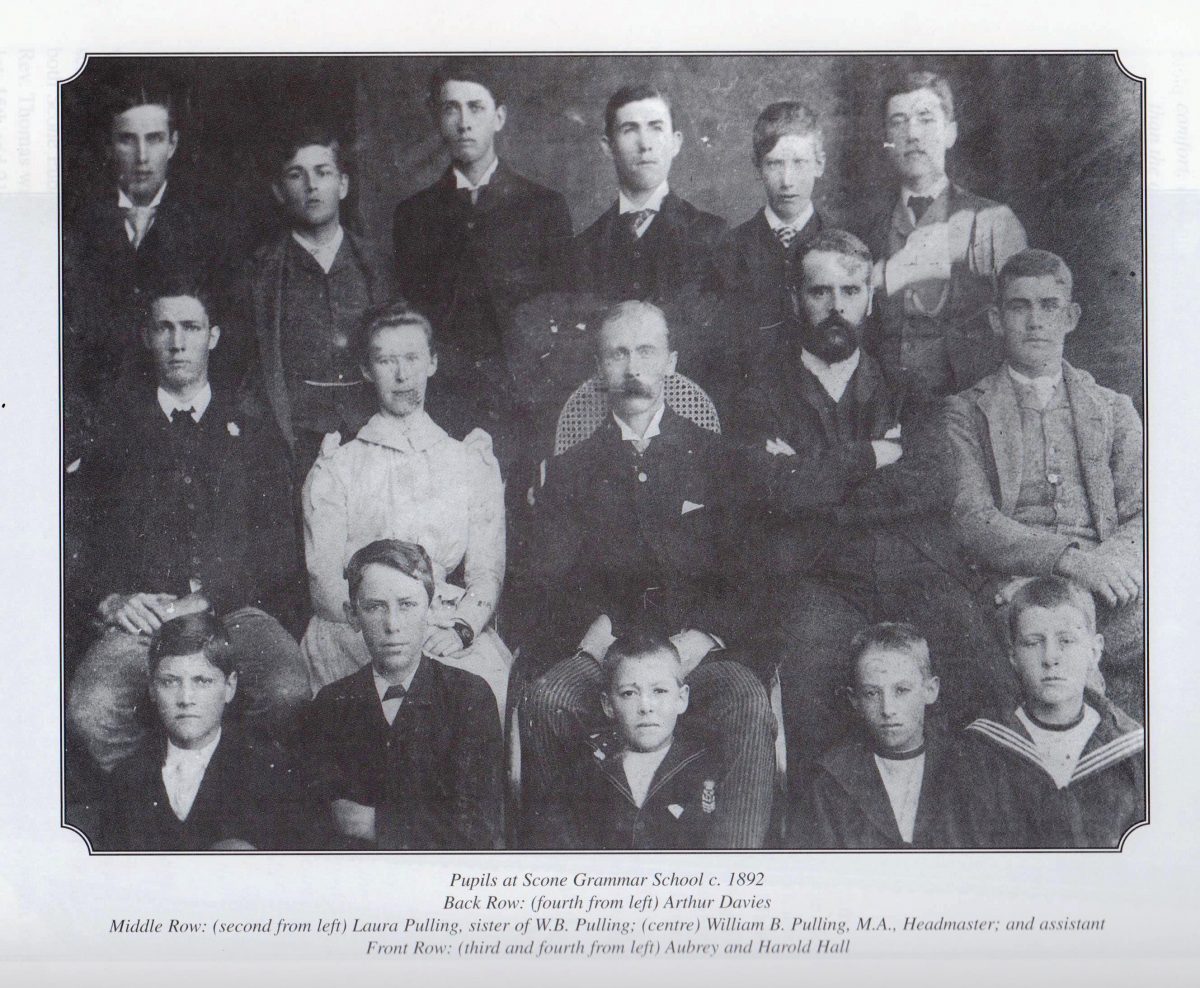William Bloomfield Pulling MA
Featured Image ‘Pupils at Scone Grammar School c 1892’; Courtesy of:
‘The Inn, The Dentists and The School’ (Federation Publication No. 2; Published by Scone and Upper Hunter Historical Society 1998) by Mace Bain, Roger Humphreys BDS and Gillian Blandford Hayes
I have mentioned many times the vitally important contribution made by professionally trained protagonists who bring their erudition and ‘worldliness’ to emerging colonial communities. Teachers were among the most important early cadres.
William Bloomfield Pulling was one of the very best. St Luke’s School had operated in Scone from 1845 – 1876. On 24 October 1844 the Rev John Morse, Rector of St Luke’s Scone Parish, Mr John Bingle of Puen Buen, and Captain William Dumaresq of St Aubins met in the vestry of the newly completed St Luke’s Church to consider the establishment of a school in Scone. It was decided to erect a schoolhouse and master’s residence for that purpose on the corner of Kingdon and Hill Streets. The project was a bold one for Scone was at that time a tiny place. Up until 1880s there was no secondary school in Scone. Primary education was offered by St Luke’s, the National School and Mrs Coombes’ school for girls. Many were obliged to attend schools in larger towns such as Maitland, Newcastle and Sydney.
St Luke’s ceased operation in 1876 after a lifetime of thirty one years. The unused schoolroom was used as a church hall. In 1886 the Rev A C Thomas of St Luke’s determined to find a suitably trained teacher to establish the Grammar School. Fortuitously he contacted William Pulling MA then ‘Scholar’ at Corpus Christi College, Cambridge; also the alma mater of the Rev Thomas. Pulling was at that time Assistant Master at King’s School, Rochester, Kent. He agreed to come to the Grammar School and arrived in Scone in April 1887 as its first headmaster. On 18 July 1887 the Grammar School commenced its first term ‘open to Day boys, Weekly Boarders and Boarders’.
William Pulling although still a young man was a person of prodigious capabilities. He became a member of St Luke’s Parochial Council in 1888 and was a Worshipful Master of Scone Lodge No. 183. He was a great supporter of Scone Hospital and a great friend of D H J H Scott after whom the hospital was later named. The June 1890 Hospital Committee was attended by Edward Solomons, J A K Shaw, J J Dodd, W B Pulling J H Doyle, H J H Scott and P Norman. William Pulling was Auditor of the first Scone Municipal Council elected in 1888 and remained so until his death in 1894.
William’s brother J Lee Pulling soon joined the burgeoning school as Assistant Master. In 1891 William was still serving on the Parochial Council. At that time Masters also served as lay-readers at St Luke’s allowing the Minister to conduct services once a month at outlying churches such as Upper Wybong. During the year (1891) Laura Alexandra Pulling arrived to assist her brothers. The Scone Grammar School continued to prosper and was classified as having an Upper Grammar School and a Lower Grammar School.
In the middle of all this progress William Pulling died suddenly at the school at the very young age of 34 on 30th October 1894. He had established a school of excellent repute with the emphasis on languages, and which became the stepping stone for students from a very wide area to move on to higher education in Sydney and beyond.
In her excellent account in ‘The Inn, The Dentists and The School’ (Federation Publication No. 2; Published by Scone and Upper Hunter Historical Society 1998) by Mace Bain, Roger Humphreys BDS and Gillian Blandford Hayes; the latter writes:
William Bloomfield Pulling was laid to rest by a large contingent of mourners in the Church of England Cemetery. His headstone bears the inscription “Cut off in Life”. A tablet was inscribed to his memory and installed in St Luke’s Church by boys and old boys of the School, such was the respect with which he was held. Some years later his close friend Dr H J H Scott died on 23 September 1910 and at his own request was buried alongside William Pulling. They had worked on many town projects together and had become boon companions. Both headstones have Masonic markings the Masonic Lodge being an important part of their lives.
William Pulling was succeeded in early 1895 by an equally compelling Headmaster in Charles W Rock MA.










